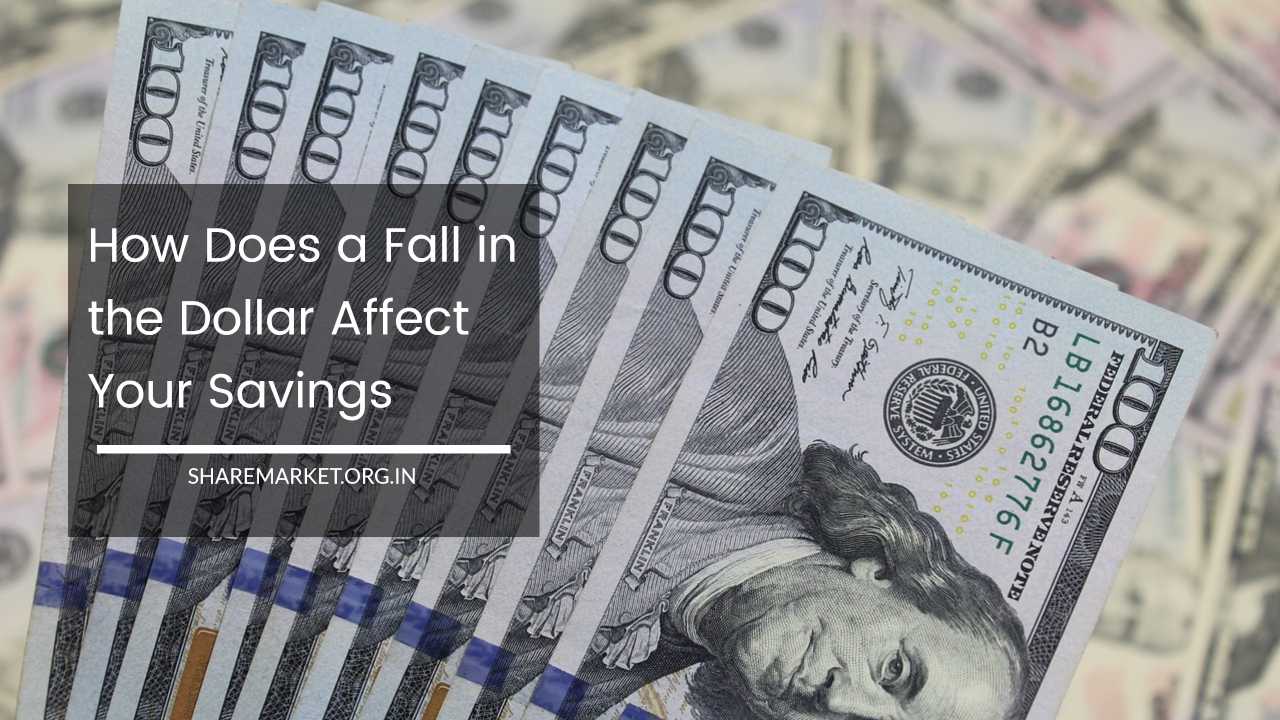How Does a Fall in the Dollar Affect Your Savings

Fall in the Dollar Affect Your Savings
How Does a Fall in the Dollar Affect Your Savings?
Understanding the Dollar-Rupee Dynamics
For many Indians, the dollar-rupee exchange rate is a key economic indicator with significant implications for personal finances.
The exchange rate reflects the value of one currency relative to another and can influence various aspects of the economy, from import and export prices to the value of investments and savings.
When we talk about a “fall in the dollar,” we’re referring to a situation where the US dollar depreciates relative to the Indian rupee. This means that the value of the dollar decreases in terms of rupees, making it cheaper for Indians to purchase dollars.
Understanding the dynamics of how a falling dollar impacts the economy and individual savings is essential for making informed financial decisions.
The effects of a falling dollar can be complex and multifaceted, influencing everything from the cost of imported goods to the performance of international investments.
What Does a Fall in the Dollar Mean?
A fall in the dollar implies that the rupee has gained strength relative to the dollar. This appreciation of the rupee can have several economic consequences:
- Imports: When the dollar weakens, the cost of importing goods from the US decreases. For Indian consumers, this can lead to lower prices for a range of products, including electronics, machinery, and raw materials. For businesses that rely on imported goods, the reduced cost can lead to lower production expenses and potentially lower prices for consumers.
- Exports: On the flip side, a stronger rupee makes Indian goods and services more expensive for foreign buyers. This can lead to a decrease in demand for Indian exports, affecting export-oriented industries such as textiles, pharmaceuticals, and IT services. A decline in exports can impact economic growth and employment in these sectors.
- Foreign Investments: Foreign investors might find Indian assets less attractive when the rupee strengthens. The returns on investments in India, when converted back to dollars, could be lower. This could lead to a reduction in foreign direct investment (FDI) and portfolio investments, potentially impacting economic growth and capital markets.
- Remittances: For Indians working abroad, the value of remittances sent back home decreases when the dollar falls. This reduction in remittance value can affect the purchasing power of families in India who rely on these funds for their daily expenses and savings.
Impact on Your Savings
The effect of a falling dollar on your savings depends largely on the types of investments and savings instruments you hold. Let’s explore how different types of savings are impacted:
Rupee-Denominated Savings
- Fixed Deposits and Savings Accounts
Fixed deposits (FDs) and savings accounts are typically denominated in rupees. A fall in the dollar does not directly impact the principal or interest earned on these deposits. However, broader economic conditions influenced by currency fluctuations can have indirect effects. For instance, if the central bank adjusts interest rates in response to changing economic conditions, this could affect the returns on fixed deposits and savings accounts.
When the rupee strengthens, the Reserve Bank of India (RBI) might adjust interest rates to stabilize the economy. Lower interest rates can reduce the returns on fixed deposits, making them less attractive compared to other investment options. Conversely, higher interest rates could increase the attractiveness of rupee-denominated deposits, potentially offsetting the effects of a falling dollar.
- Real Estate
Real estate investments are not directly linked to the dollar, but they can be influenced by broader economic conditions. A stronger rupee could make Indian real estate more appealing to foreign investors, leading to increased demand and potentially driving up property prices. This could benefit property owners and investors by increasing the value of their real estate holdings.
Additionally, if the economic environment becomes more favorable due to a stronger rupee, it could boost domestic demand for real estate. This increased demand could further contribute to rising property prices, benefiting investors and homeowners.
Dollar-Denominated Savings
- NRI Deposits
Non-Resident Indian (NRI) deposits are held in dollars, so a fall in the dollar reduces their value in rupee terms. For NRIs, this means that the amount of money they have saved or invested will be worth less when converted into rupees. Despite this, dollar-denominated deposits often offer higher interest rates compared to domestic savings accounts, which can help offset some of the losses due to currency depreciation.
NRIs may also consider diversifying their investments to balance the impact of currency fluctuations. While a falling dollar can reduce the value of their savings in rupee terms, the higher interest rates and potential benefits of holding dollars might still provide some level of financial advantage.
- US Stocks and Bonds
Investments in US stocks and bonds are valued in dollars. When the dollar falls, the value of these investments in rupee terms decreases. For Indian investors holding US stocks and bonds, this means that their investment returns will be lower when converted back into rupees. However, it’s important to consider the performance of these investments in the US market. If the underlying assets perform well and provide strong returns in dollar terms, the impact of currency depreciation may be mitigated.
Investors should evaluate the performance of their US-based investments relative to the dollar’s movement. Diversification across various international markets and asset classes can also help manage currency risk and potentially reduce the impact of fluctuations.
Gold
- Gold as a Hedge
Gold is often considered a safe haven asset and a hedge against currency fluctuations and inflation. The price of gold tends to rise during times of economic uncertainty and currency volatility. Although gold is not directly correlated with the dollar, its price can be influenced by global economic conditions, including changes in exchange rates.
When the dollar falls, the price of gold may increase as investors seek refuge in assets perceived as stable and valuable. Holding gold as part of an investment portfolio can provide protection against currency depreciation and inflation, potentially preserving the value of savings in times of economic instability.
Factors Affecting the Dollar-Rupee Exchange Rate
Several factors influence the fluctuations in the dollar-rupee exchange rate, including:
- Interest Rate Differentials
The difference in interest rates between India and the US plays a crucial role in determining capital flows and currency values. Higher interest rates in India can attract foreign investments, leading to an appreciation of the rupee. Conversely, lower interest rates can weaken the rupee by making Indian assets less attractive to foreign investors.
Central banks, such as the Reserve Bank of India (RBI) and the Federal Reserve, use interest rate adjustments as a tool to influence economic conditions and stabilize their currencies. Changes in interest rates can impact exchange rates and, consequently, affect the value of savings and investments.
- Trade Balance
The trade balance, which measures the difference between exports and imports, affects the demand for currencies. A trade surplus, where exports exceed imports, can lead to a stronger rupee as foreign buyers need to purchase more rupees to pay for Indian goods and services. Conversely, a trade deficit can weaken the rupee as more foreign currency is required to pay for imports.
Changes in the trade balance can impact the exchange rate and influence the value of imports and exports. Monitoring trade trends and their effects on the currency can provide insights into potential fluctuations in the dollar-rupee exchange rate.
- Remittances
Remittances from Indians working abroad contribute to the demand for rupees. Increased remittance inflows can support the rupee and lead to its appreciation. This can benefit families in India who rely on remittances for their daily expenses and savings.
Fluctuations in remittance inflows can affect the currency value and impact the overall economy. Understanding the trends in remittance flows and their effects on the rupee can help individuals and policymakers anticipate potential changes in the exchange rate.
- Foreign Direct Investment (FDI)
Foreign direct investment (FDI) represents investment by foreign entities in Indian businesses and assets. High levels of FDI can contribute to the strengthening of the rupee, as foreign investors need to convert their currency into rupees for their investments. Increased FDI can also signal confidence in the Indian economy and lead to positive economic growth.
Monitoring FDI trends and their impact on the rupee can provide insights into potential currency movements and their implications for savings and investments.
- Geopolitical Factors
Global political events and economic conditions can impact currency values and exchange rates. Events such as trade wars, geopolitical conflicts, and economic sanctions can create uncertainty and lead to fluctuations in currency values. These geopolitical factors can influence investor sentiment and impact the value of the dollar and the rupee.
Staying informed about global economic and political developments can help individuals and investors anticipate potential currency movements and adjust their strategies accordingly.
Hedging Your Bets
Given the potential impact of currency fluctuations on your savings, implementing strategies to manage risk and protect your investments is crucial. Here are some effective strategies to consider:
- Diversification
Diversifying your investment portfolio across different asset classes and currencies can help reduce risk and mitigate the impact of currency fluctuations. By holding a mix of rupee-denominated and dollar-denominated assets, you can balance potential gains and losses. Diversification can also include investing in various asset types, such as equities, bonds, real estate, and commodities.
Diversification helps spread risk and can provide a cushion against adverse movements in any single asset class or currency. It’s important to evaluate your investment portfolio regularly and adjust your holdings based on your financial goals and risk tolerance.
- Dollar-Cost Averaging
Dollar-cost averaging involves investing a fixed amount of money at regular intervals, regardless of the exchange rate. This strategy helps smooth out the impact of currency fluctuations and reduces the risk associated with market timing. By consistently investing over time, you can average out the cost of your investments and potentially benefit from market volatility.
Dollar-cost averaging can be particularly useful for long-term investors who want to build wealth gradually and reduce the impact of short-term currency fluctuations.
- Hedging Instruments
Financial instruments such as currency futures, options, and swaps can be used to hedge against adverse exchange rate movements. These instruments allow you to lock in exchange rates or protect your investments from currency risk. Hedging strategies can help mitigate potential losses due to currency fluctuations and provide greater stability for your investments.
It’s important to understand the mechanics of hedging instruments and their associated costs before implementing these strategies. Consulting with a financial advisor or specialist can help you determine the most appropriate hedging approach for your investment portfolio.
- Consult a Financial Advisor
Seeking professional advice from a financial advisor can provide personalized guidance tailored to your specific financial goals and risk tolerance. A financial advisor can help you develop a comprehensive strategy to manage currency risk and optimize your investment portfolio. They can also offer insights into market trends, economic conditions, and potential opportunities for growth.
Working with a financial advisor can enhance your ability to navigate the complexities of currency fluctuations and make informed decisions about your savings and investments.
Final Remarks
A falling dollar can have significant implications for your savings and investments, influencing various economic factors and financial assets.
Understanding how currency fluctuations impact different types of savings and investments is essential for effective financial management.
By adopting strategies such as diversification, dollar-cost averaging, and hedging, you can navigate the challenges posed by currency movements and safeguard your financial well-being.
Consulting with a financial advisor can provide valuable insights and tailored advice to help you achieve your financial goals and manage currency risk.
Staying informed about economic trends, market developments, and geopolitical factors can also enhance your ability to make strategic decisions and optimize your investment portfolio.
In an ever-changing economic landscape, proactive planning and informed decision-making are key to protecting and growing your savings.
By understanding the dynamics of currency fluctuations and implementing effective strategies, you can better navigate the complexities of the foreign exchange market and achieve financial stability and success.

















